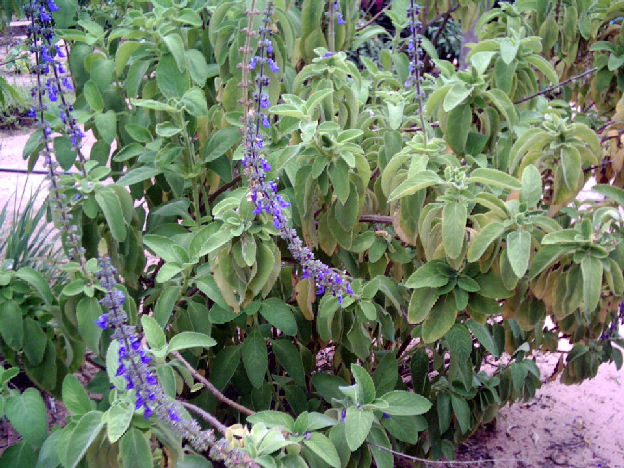

Salvia officinalis (Genuine Sage)
The Genuine Sage (Salvia officinalis), also called Garden sage, Kitchen sage or salvia salvation, is one to 32 inches tall shrub from the genus Salbei. The evergreen spice and medicinal plant is native to the Mediterranean area, but not spread throughout Europe and in South America.
The Genuine Sage is a traditional plant of the country gardens. All its parts have a strong aromatic smell. As a heat-loving plant of Mediterranean origin it is in Central Europe only limited hardy and requires winter protection in colder regions. It is therefore little competitive against wild plants and rare wild. The Genuine Sage grows best on calcareous, stony and dry soil.
The purple, rarely pink or white flowers have the typical form of the Labiatae.
The sage contains the main active ingredients, which are the essential oils thujone and 1.8-cineol, tannins and bitter. In case of overdose, the essential oil is toxic by its content of thujone. The use of sage as a house tea for the duration of use is therefore considered doubtful. Although thujone is mainly fat and alcohol soluble, but has been shown in recent studies by the University of Hamburg, that due to slight solubility of thujone, a sustainable use of sage tea starting at 1-2 cups a day as a "safety concern" should be classified. It should be noted furthermore, a high thujone in alcoholicd extracts such as in imported absinthe.
The use of sage as a medicine has a long tradition. As a spice it held until the Middle Ages its way into our kitchen, but soon got the reputation, among the herbs to prevent the rancidity of fats.
The sage smells fragant and tastes spicy and bitter. The spice is used for meat dishes, wild meat, chickens, sausages, fish dishes and herb cheese. Especially for fatty foods sage fits well, because it promotes the wholesomeness of heavy fare. The sage is one of the few herbs that can also be used dried well.
Traditionally the antibacteria, anti-inflammatory and astringout effect is known. In inflammations of the mouth and throat are used commercially available aqueous or alcoholic extracts and gargle. The sage can also be used for gargling or drinking. It is said to have a sweat effect. The ingredients of medicinal sage will also contribute excitosecretory and support the function of the nervous system.
The sage is one of the plants, which should not be taking a long time in high doses. Breastfeeding should take no sage or other products, since otherwise can dry up the flow of milk, unless you want to wean.

Genuine Sage in our garden in January 2008.
Back to the Agricultural Plant List
Created by Joachim Jaeck on December 1st, 2009